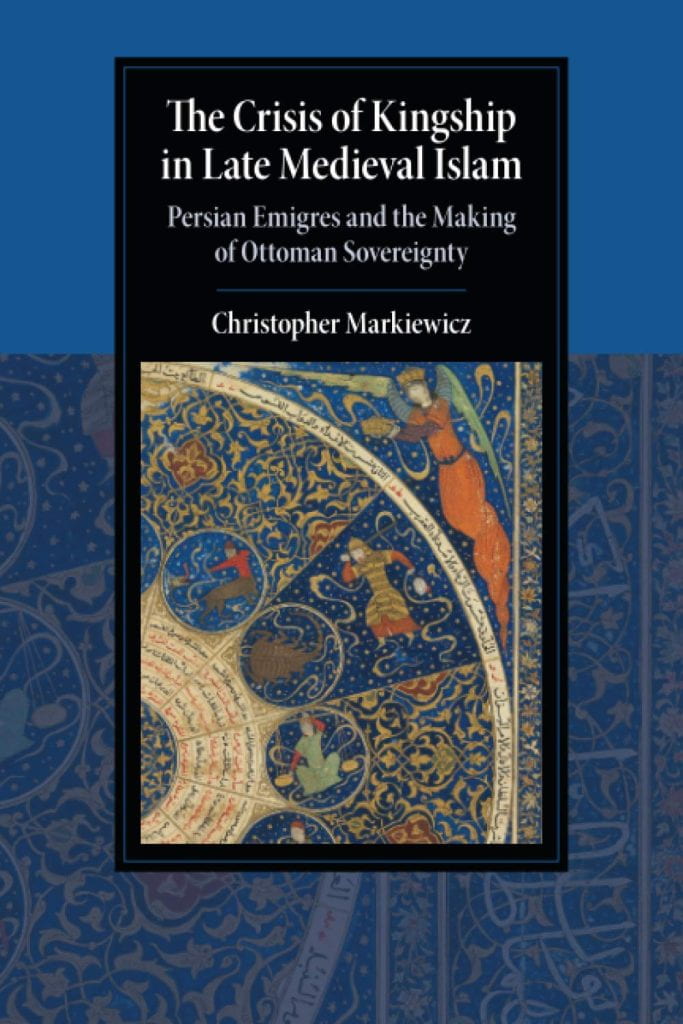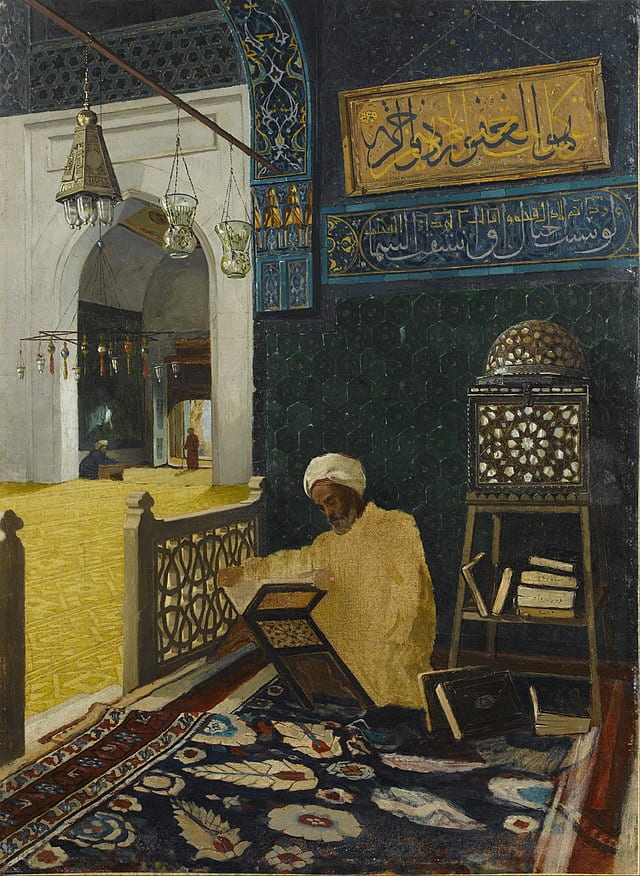by Nilab Saeedi
Professor Christopher Markiewicz‘s comprehensive study The Crisis of Kingship in Late Medieval Islam, published in 2019, focuses on the life and experiences of Idrīs-i Bidlīsī (d. 926/1520), a Persian scholar and chancellor who served in both the Aqqoyunlu and Ottoman courts. A significant contribution to our understanding of the late medieval period, the study goes beyond a mere examination of Bidlīsī’s personal history. Instead, Markiewicz skillfully weaves a tapestry of various political concepts and ideas that preoccupied Islamic statesmen and intellectuals of the fifteenth century. The book not only explores the intellectual landscape of the time, but also sheds light on how these ideas resonated and were adopted in the various Muslim states during this historical period.
Nilab Saeedi: Thank you for your generosity in taking the time to speak with me. I greatly appreciated your book, The Crisis of Kingship in Late Medieval Islam, which since 2019 has become a required reading for students of Islamic intellectuals and ideas. To begin, I would like to focus on the central figure of your narrative, Idrīs-i Bidlīsī. Can you provide some insights into the main figures of your book and offer a deeper understanding of Idrīs-i Bidlīsī’s role and importance within the intellectual and political landscape you have explored?
Christopher Markiewicz: Thank you, Nilab, for the invitation. I am very happy to speak with you about my book. In it, I tried to explain why an innovative concept of kingship spread across Islamic lands in the fifteenth century and became the most important way Muslim empires in the sixteenth century expressed their imperial ideologies. On one level, I focused on Idrīs-i Bidlīsī because several aspects of his life, work, and thought helped me tell this wide-ranging history in a concrete, grounded way. On another level, Idrīs-i Bidlīsī simply led a fascinating life. He was born in a village in northern Iran in the mid-fifteenth century while his father was studying as a disciple of a major Sufi master and messianic figure. He grew up within the learned Sufi circles of his father, yet as a young man, he entered into the political life of a major sultanic court in Iran, where he worked for the next twenty years within its chancery. When Iran faced enormous political upheaval with the emergence of the Safavids, he fled to the Ottoman court, where he produced a major dynastic history of the Ottomans, the work he is perhaps best known for. So, Bidlīsī’s life allows us to cover a broad geography, but through his life, we can connect his activities and work to many of the most salient features that underpinned thinking on kingship during this period.

NS: Your work meticulously traces Idrīs-i Bidlīsī’s migration between courts and his role in shaping the intellectual climate of the 15th century. Could you elaborate on the specific intellectual networks to which Idrīs-i Bidlīsī belonged? How did his active participation in these networks contribute to the development and dissemination of new political ideas during this period?
CM: I think Bidlīsī helped to shape certain aspects of Ottoman kingship in the early sixteenth century, but he was also part of a much wider intellectual climate, and so it’s also clear this wider climate equally shaped him. Sufi thought was a major part of this intellectual climate, and throughout his life, Bidlīsī was immersed in it. He was also connected with many Sufis, but these connections also cut across the different formal networks of Sufi orders. The example of Bidlīsī is important because his life unfolded both in Iran and in Ottoman lands. Through him, and other emigres like him, we can see in concrete terms how certain ideas about kingship that were developed in Iran in the fifteenth century became much more widespread. When Bidlīsī moved to the Ottoman court in the early sixteenth century, we can connect him with a wider group of Persian émigrés who left Iran after the emergence of the Safavids. A number of these emigres, like Bidlīsī, worked within chanceries or courts outside of Iran, whether in Ottoman lands or in Central and South Asia. Like him, they also wrote histories or political treatises, so through their examples, we can see how they contributed to spreading a new vocabulary of sovereignty throughout Islamic lands.
NS: In your book, you discuss Idrīs-i Bidlisī’s magnum opus, Hasht Bihisht. There, you suggest that history was central to the development of Bidlīsī’s ideas about kingship. Can you explain Bidlisī’s methodology in Hasht Bihisht to articulate and disseminate his specific ideas about kingship?
CM: Hasht Bihisht, or The Eight Paradises in English, is a dynastic history that Idrīs-i Bidlīsī wrote recounting and celebrating the deeds of the eight Ottoman sultans who ruled until his own day. But the work is not a simple laudatory text produced for his Ottoman patrons. Complete copies of the work amount to more than 600 manuscript folios. In addition to historical narrative, which lies at the heart of the work, Hasht Bihisht includes poetry, lengthy discourses on the meaning of history, discussions of astronomy and other sciences, creative exegeses of Quranic references, and extensive discourses on the conceptual attributes of the just and ideal ruler. The inclusion of all of these varied discussions drawing from different sources of knowledge was largely the product of how Bidlīsī conceived of history, which, for him, was the pinnacle of the rhetorical sciences since its practice depended upon use of the widest array of learning to make sense of the historical past with the aim of persuading others. So, in his history, Bidlīsī developed complex conceptions of the ideal ruler grounded in these varied bodies of knowledge. He then sought to associate these concepts with the Ottoman sultans and substantiate these claims through his historical narrative.
NS: The book suggests that intellectuals such as Idrīs-i Bidlisī played a key role in influencing Ottoman political culture. Can you describe the ways in which Idrīs-i Bidlisī’s ideas shaped Ottoman politics?
CM: Well, one way that Bidlīsī had an impact was through his history. In his own lifetime, he received criticism from some quarters for the overly florid style in which he wrote. In the longer term, his approach won out since most Ottoman historians of the sixteenth century sought to write in an ornate style in Ottoman Turkish that embraced the same approach to historical writing advocated by Bidlīsī. They also continued to use many of the same titles and concepts of kingship used by Bidlīsī in his history. But the impact of Bidlīsī and others also went beyond history writing. Since they also frequently worked within the Ottoman chancery or in other official capacities, they deployed these concepts and terms in the documents produced by the Ottoman court, such as diplomatic correspondence and the preambles to laws. So, in this way, their ideas about kingship became widely accepted within Ottoman ruling circles as the appropriate mode to define the sultan and his sovereign role.
NS: Your book emphasizes the lasting influence of Idrīs-i Bidlisī on future Ottoman historians and their literary expectations. Can you examine in a nuanced way how Idrīs-i Bidlisī’s ideas persisted in Ottoman historiography? Are there specific instances in which later historians consciously imitated Idrīs-i Bidlisī’s distinctive literary style or adopted key aspects of his conceptual framework?
CM: Well, I think Bidlīsī had a somewhat mixed legacy among Ottoman historians. On one level, he was welcomed at the Ottoman court and encouraged to produce a massive history in Persian. At this time, and indeed over the course of the Ottoman Empire, Persian was a valued and cultivated language of culture among the Ottomans, yet during Bidlīsī’s lifetime, other Ottoman intellectuals were working to develop Ottoman Turkish as a literary language. Over the sixteenth century, Ottoman historians overwhelmingly wrote in this literary Turkish language. Yet, in doing so, they largely accepted the aesthetic views and methodological approach advocated by Bidlīsī in his history. Many of the leading Ottoman historians of the sixteenth century, including Kemalpaşazâde (d. 940/1534), Celâlzâde Mustafa (d. 975/1567), and Mustafa Âlî (d. 1008/1600), incorporated the kinds of discourses found in Bidlīsī’s history into their own works, and in many instances used the same titles and other concepts of rule. Of course, they offered their own ideas and responded to the conditions of their own day, yet their basic approach to writing history continued to share much with Bidlīsī.
NS: The concept of khilāfat-i raḥmānī, attributed to Idrīs-i Bidlisī, is characterized as a “coherent vision of kingship” for the Ottoman sultans. How did this concept differ from more traditional approaches to legitimizing Ottoman rule? Furthermore, could you elaborate on the challenges or debates that arose in intellectual and political circles as a result of Idrīs-i Bidlisī’s proposal of this new vision of kingship?
CM: The concept of khilāfat-i raḥmānī is not something that Bidlīsī invented, but it was something that he made his own in his writings. It is an idea of rule rooted in Sufi thought. The concept suggests that at any one time, there is one individual in the world who has attained such spiritual mastery to assume the axial role as God’s vicegerent, that is khalīfa. For Sufis, this is attained through an inward conditioning of one’s soul that amounts to perfect justice and is outwardly expressed through the possession of perfect courage, wisdom, restraint, and justice (the same four cardinal virtues of Greek philosophy). The concept clearly has political ramifications for rule and, indeed, for Bidlīsī, it was the basic concept of kingship that he articulated throughout his writings and associated with the Ottoman rulers. The term itself, khalīfa, is the same term used for caliph, yet the understanding of what this actually meant differed radically from the earlier conception of the caliphate, which was defined quite precisely in juridical terms. Bidlīsī’s ideas about this caliphate (that is, about khilāfat-i raḥmānī) were grounded in Sufi cosmologies and not jurisprudence. Bidlīsī was far from alone in this approach to rule, and indeed, this conception of rule emerged widely in the sixteenth century among the Ottomans, Safavids, and Mughals, the major Muslim empires of the early modern period.
NS: Thank you for sharing your expertise and insights with us in this interview. Your thoughtful responses have added depth and richness to our discussion and provided a valuable perspective on the intellectual and political landscape of late medieval Islam. I am truly grateful for your time, your generosity, and the wealth of knowledge you have shared with us. Your commitment to this field is inspiring, and I am sure that your contributions will resonate with readers and students alike.
CM: Thank you, Nilab. It was a pleasure to have the chance to speak with you today.
Nilab Saeedi is a researcher at the Institute for Habsburg and Balkan Studies at the Austrian Academy of Sciences in Vienna, Austria. She is also pursuing her doctoral studies in history at İbn Haldun University in Istanbul, Turkey. Nilab holds a Master of Arts (M.A.) in Ottoman Literature and a Bachelor of Arts (B.A.) with a double major in Modern Languages and Persian Studies. She has also worked in the field of education as a Teaching Fellow at İbn Haldun University. Nilab’s research focuses on early modern Ottoman history, the intellectual legacy of Islamic scholarship, and manuscript studies. Fluent in several languages, including Turkish, English, Arabic, Ottoman Turkish, Persian, Uzbek, Hindi, Urdu, and Kurdish, and with a basic knowledge of German. Nilab is currently working on her doctoral dissertation entitled “MUṢLIḤ AL-DĪN AL-LĀRĪ” (d. 979 / 1572) “AN INTELLECTUAL OF THREE EMPIRES,” which explores the life of a Muslim scholar who played a significant role in the Safavid, Mughal and Ottoman Empires.
Edited by Artur Banaszewski
Featured Image: Osman Hamdi Bey, Kur’an Tilaveti, Reciting the Quran, Sakıp Sabancı Museum, Istanbul. Courtesy of Wikimedia Commons.



